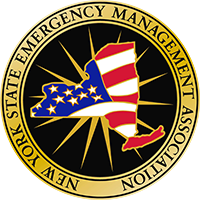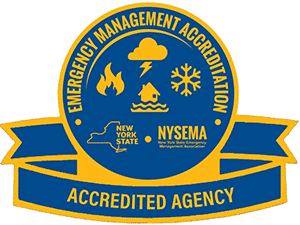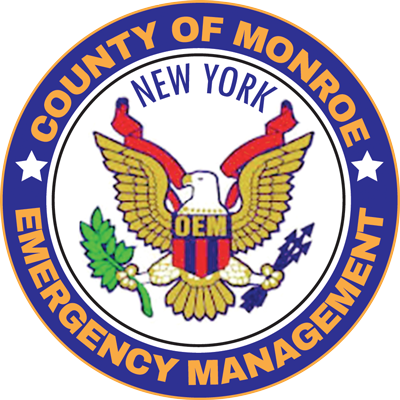- The Office of Emergency Management maintains and distributes the Monroe County Comprehensive Emergency Management Plan (CEMP) as well as multiple hazard specific and functional annexes to the plan. This CEMP serves as the framework for the manner in which the County government will manage emergencies, disasters, or large-scale planned events.
- OEM is also responsible for maintaining and updating the Monroe County Hazard Mitigation Plan (HMP). The HMP is a requirement for the County, and participating municipalities, to remain eligible for funding through FEMA’s Hazard Mitigation Assistance Grants.
- In February 2023, OEM received accreditation through the New York State Emergency Management Association (NYSEMA). NYSEMA Accreditation is a formal recognition that an office's policies and practices meet or exceed standards in all primary aspects of emergency management and is valid for five years. In accordance with accreditation, OEM also maintains a Continuity of Operations Plan. This plan provides guidelines and procedures for OEM staff to stand up an alternate Emergency Operations Center (EOC) in the event the County’s main EOC is unavailable.
- Accreditation records and emergency plans are on file and are available (as required) through OEM.
1190 Scottsville Rd., Suite 200
Rochester, New York 14624
Phone: (585) 753-3810
Fax: (585) 473-7087
On This Page

Timothy P. Henry
Deputy Director of Public Safety & County Emergency Manager


 Comprehensive Emergency Management
Comprehensive Emergency Management
The Office of Emergency Management (OEM), under Monroe County Emergency Manager Tim Henry, executes the County's Comprehensive Emergency Management Plan for disaster relief before, during and after any type of natural or human-made disaster or a wartime situation. In accordance with State Executive Law, Article 2B, the office develops and maintains a comprehensive emergency management plan to include prevention/mitigation, preparedness, response and recovery guidelines. OEM plans and coordinates with government and non-government agencies for rapid response in an emergency, and assists towns and villages in the preparation of their emergency response plans, as requested. OEM, with guidance from the Federal Emergency Management Agency (FEMA), develops and continually reviews the Monroe County Radiological Emergency Preparedness Plan (MCREPP) in case of an incident at the Ginna Nuclear Power Plant. OEM conducts multiple exercises a year testing its REPP.
In relation to Monroe County's Radiological Program, OEM receives funds from New York State to support radiological monitoring, communications, shelter/evacuation, and associated operations. State law (Chapter 708 of the Laws of New York State, 1981) requires the nuclear utilities to finance system enhancements. Funds obtained through the New York State Radiological Emergency Preparedness Program are used to enhance County resources.
What We Do
Our Mission Statement
On behalf of County Executive Adam J. Bello, the Office of Emergency Management maintains and administers an integrated Emergency Management program designed to assure a safe environment through prevention/mitigation, preparedness, response, and recovery activities.
Prevention/Mitigation
A. Plans for emergency response
B. Provide public information and education
- Public Officials Workshop
- NYS Dept. of Homeland Security & Emergency Services Mandated Tier 3 Training
- ICS 300 Training & ICS 400 Training
- Work in conjunction with the National Weather Service Buffalo for SKYWARN Training
- Community outreach and preparedness training
Preparedness
- 24/7/365 availability to respond
- Emergency Operations Center and related services
- Notification protocols at the 9-1-1 center
- Incident critique
Response
Procure and provide personnel/equipment resources and secure community-wide resources of government and private agencies for: communications, evacuation, sheltering, health concerns, security, transportation, recovery and re-entry procedures. OEM can also request state and federal resources through the NYS Department of Homeland Security & Emergency Services.
OEM staff may respond to the incident scene to serve as a liaison from the Command Post back to the Emergency Operations Center.
Recovery
- Re-entry and recovery information
- County disaster financial assessment processing
- Mitigation activities
Office of Emergency Management’s Vision for Diversity and Inclusion
Monroe County, NY Office of Emergency Managements continued vision statement on its role fostering diversity, equity and inclusion:
“Maintaining an inclusive and equal environment in which the Monroe County Office of Emergency Management leverages individual and community diversity to further increase our emergency response effectiveness in public safety efforts and all local disaster relief objectives, and to maximize the potential of the individuals of our organization and the communities and organizations that rely on our office.”
Our Monroe County Emergency Manager and leadership remains fully committed to creating a diverse workplace environment and challenges each member of its staff to promote diversity, inclusion, equity, and respect not only in the workplace, but out in the field during times of community crisis as well.
It is vitally important that our office continues to foster a strong culture of inclusion, diversity, respect and equity to further promote an environment that embraces and allows each and every member of our staff an equal opportunity to achieve their full potential. We know that when everyone’s skills, talents, experiences, culture and characteristics are brought to the table it will help broaden the range of approaches to our work not only in emergencies, but in training and in our offices as well.
County Emergency Operations Center (EOC)
Monroe County’s Emergency Operations Center is a specially designed facility where public organizations and private-sector agencies meet to coordinate and support emergency response to community-wide disasters.

HAZMAT Response Plan
The Monroe County Hazardous Materials Response Plan has been prepared to meet statutory planning requirements of the federal Superfund Amendments and Reauthorization Act of 1986, SARA, Title III, and to develop a higher degree of community preparedness for incidents involving hazardous materials.
This plan provides basic guidelines and establishes responsibilities for response to a hazardous materials incident in Monroe County. This plan will provide appropriate guidelines for response to the release of hazardous materials beyond the boundary of a facility using, storing or producing hazardous materials, and the release of hazardous materials that has the potential to injure or harm the population or the environment. All incidents must be reported, controlled and thoroughly investigated.
Facilities and political subdivisions within the jurisdiction of this plan, should establish and maintain operational plans and procedures that are compatible and consistent with this plan.
Homeland Security Funding
Homeland Security Funding is received and distributed by the Office of Emergency Management. Funding sources include: State Homeland Security Preparedness (SHSP), State Law Enforcement Terrorism Prevention Program (SLETPP), Urban Area Security Initiative (UASI), Port Security Grant Program, Critical Infrastructure Key Resources (CIKR) Grant Program, Local Emergency Management Planning Grant (LEMPG) and the Hazardous Materials Emergency Preparedness Grant Program.
Radiological Preparedness
The Monroe County Office of Emergency Management has made the following document available in order to provide detailed information to County residents that reside within the ten-mile Emergency Planning Zone (EPZ) surrounding the Ginna Nuclear Power Plant.
If you live in one of the nine Emergency Response Planning Areas (ERPA), then this document will help you to make critical decisions and provide important information in the event of a nuclear emergency. This information should be used to help you and your family to prepare a nuclear emergency response plan for your home. You can also find this information in the back of the Constellation Energy Emergency Planning Information Brochure for Monroe County.
- Download the Ginna Monroe County Brochure
- Download Postcard for People with Access & Functional Needs
- Download a larger image of the Ginna Map
Information provided includes:
- Emergency Alert System (EAS) notification. A listing of available radio stations that provide emergency information.
- Emergency Response Planning Area (ERPA) and Reception/Congregate Care Center (R/CCC) information. Find out where to go and what to bring during a nuclear emergency in your area.
- Other evacuation and sheltering information.
- Information about radiation and basic radiation protection measures.
- Information about Potassium Iodide (KI) in a nuclear emergency.
- Contact numbers and where to receive more information.
- Download the 2023 NYS RPP Agriculture Brochure
Monroe County Emergency Response Planning Areas (ERPAs) (click to enlarge)

KI (Potassium Iodide)
The County of Monroe, in partnership with Wegmans Food Markets, distributes Potassium Iodide (KI) to residents of Monroe County who live within the 10-mile Emergency Planning Zone (EPZ) of the Ginna nuclear power plant located just east of Monroe County in Wayne County.
Since the tragic events of September 11, 2001, federal, state and local governments have all acted to strengthen security and further protect the public. In December 2001 the Food and Drug Administration (FDA) issued a new recommendation for the distribution of KI to residents adjacent to nuclear power plants. The KI is to be taken only under emergency conditions and is intended as an additional safety precaution. It does not replace the existing emergency plan to evacuate or shelter-in-place during a radiological emergency.
Potassium Iodide protects the thyroid gland from radioactive iodines. Such iodines could be released into the atmosphere only in the most serious type of a nuclear accident. It is not a substitute for more familiar and thorough emergency preparedness steps, such as sheltering-in-place or evacuation. Residents should consult their physicians on KI and possible interactions with prescriptions or allergies.
The use of KI by residents is only necessary in emergencies where the public is likely to be exposed to radioiodine. The Monroe County Office of Emergency Management monitors all radiation emergencies involving the Ginna Nuclear Power Plant and will issue advisories informing the public whether KI should be taken.
Monroe County is not alone in undertaking this public safety initiative. Other communities surrounding the six nuclear power facilities throughout New York State are implementing similar programs to distribute KI to residents living near nuclear reactors.
KI (Potassium Iodide) Information
- Medical questions about KI should be addressed to your Physician.
- If you have questions about your child’s school plans, please call the Superintendent’s Office.
- Evacuation Plans: Wayne County and Monroe County evacuation plans have been prepared by local, state and federal officials. If you have questions about evacuation plans for the 10-mile Emergency Planning Zone, residents should refer to their copy of Constellation Energy's calendar, and employees should contact their employer.
- KI Distribution: The current government-funded, KI program is designed for residents and schools located within the 10-mile Emergency Planning Zone of Ginna Station. Employers within this 10-mile zone may purchase KI to have it available in the workplace. Employees who work within this 10-mile zone may want to purchase KI to have it available at their workplace.
- Anyone who lives within the 10-mile EPZ and has questions related to KI, can contact the Monroe County Office of Emergency Management at 585-753-3810.
- Additional information is available from the NYS Department of Health
Other Links:
- Nuclear Regulatory Commission (www.nrc.gov)
- Centers for Disease Control (www.cdc.gov)
- Child Care Emergency Planning template (www.rit.edu/cast/crr)
Monroe County Hazard Mitigation Plan
The Disaster Mitigation Act of 2000 amends the Robert T. Stafford Disaster Assistance and Emergency Act 42 USC 5133 by adding a new section, 322 - Mitigation Planning. Section 322 establishes a new requirement for local mitigation plans. The Act provides a framework for linking pre- and post-disaster mitigation planning and initiatives with public and private interests to ensure a comprehensive, whole community approach to disaster loss reduction. It requires all local governments to have an approved All-Hazard Mitigation Plan in place to be eligible to receive Hazard Mitigation Grant Program (HMGP) project funding.
In 2022, Monroe County, along with its 30 municipalities updated the 2017 Hazard Mitigation Plan; and the 2023 Update is now completed.The plan focuses on existing and future buildings, infrastructure, and critical facilities that natural disasters might impact. Ultimately, the mitigation projects identified and implemented will reduce vulnerability and enable communities to become more resilient to disasters.
The County profiled the hazards and their potential consequences that may impact Monroe County and its municipalities and identified Critical Infrastructure and Key Resources (CIKR) that are subject to losses or damage. It estimated the potential losses that could result from each type of hazard. The County and its municipalities have also developed a mitigation strategy that includes the identification of hazard mitigation goals as well as a prioritized list of actions designed to reduce losses.
NYS DHSES and FEMA approved the final plan. The Monroe County Legislature adopted the plan on July 11, 2023. Click the links below to view the final plan.
View Volume I - Area Wide Elements
Federally required elements of a hazard mitigation plan that apply to the entire planning area are presented in Volume I. This includes the description of the planning process, public involvement, planning area risk assessment, capabilities, goals and objectives, and plan maintenance strategy.
View Volume II - Planning Partner Annexes
Federally required jurisdiction-specific elements, presented in annexes, for each participating jurisdiction is presented in Volume II.This includes a description of the participation requirements and how each annex was developed, followed by an annex for each participating jurisdiction.















